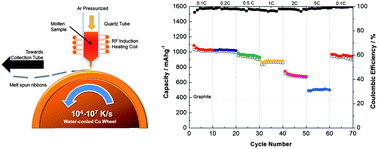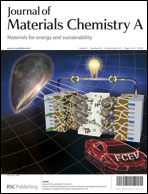Rapid fabrication of a novel Sn–Ge alloy: structure–property relationship and its enhanced lithium storage properties†
Abstract
A rapid solidification and high throughput melt spinning process is developed for the fabrication of new Sn–Ge alloys as anodes for high capacity lithium-ion batteries. Compared to pure micron-sized Sn and Ge, the alloy possesses enhanced lithium storage properties. High, reversible and stable capacities of over 1000 mA h g−1 are maintained over 60 cycles at 0.1 C. A good rate capability of 500 mA h g−1 at 5 C is also achieved, making it very attractive for very fast charge/discharge applications. More remarkably, it has a tap density of 2.05 g cm−3 and thus high volumetric capacities of 2050 mA h cm−3 at 0.1 C and 1025 mA h cm−3 at 5 C. The electrode was investigated via ex situ XRD, EXAFS and TEM at various cut-off voltages during the first cycle and after the first cycle to establish the structure–property relationship. The Sn–Ge alloy is observed to undergo a transformation from the crystalline Sn–Ge alloy into phase separated nanocrystalline Sn in an amorphous Ge matrix. The excellent lithium storage properties exhibited by Sn–Ge are attributed to the synergistic effect between the phases and the phase transformation occurred.


 Please wait while we load your content...
Please wait while we load your content...